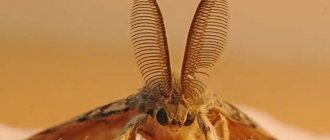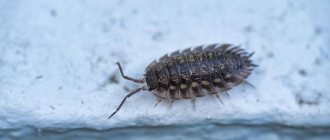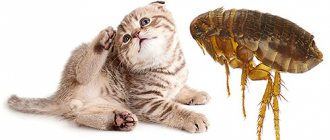Many housewives encounter moths in their apartments every day. When moths appear, they begin to panic, and not without reason. This seemingly harmless winged fly can cause serious damage to food, furniture or things. The result of their life activity is sweaters with holes, scraps of fur, eaten upholstery, ground grains and much more.
Therefore, the task of every housewife is to detect this small but large-scale pest in time, and then take measures to destroy them. The main thing is to know which drugs are the most effective in the fight against moths or you can get by with folk remedies.
Features of control by insect species
Since all types of moths still belong to the same family, the methods of combating these pests are similar. Therefore, we will not analyze the process of destroying each subspecies separately, but will divide it into only 2 classes: clothing (feeds on things made of fur, wool, natural fabrics, upholstery, furniture filler, carpet pile) and food (dangerous for food).
Check out our collection of quick cleaning tips.
Clothes moth
The fight against moths in the wardrobe begins with general cleaning:
- need to get clothes
- spread out in the sun (or take out in the cold),
- and wash the inside of the cabinet thoroughly.
Important! Treating one compartment is not enough; if the closet is large, inspect, sort through and wash every shelf, drawer, and hard-to-reach corner.
After sunbathing, be sure to wash items on which larvae are found in water at the maximum permissible temperature for the fabric. If the moth is a furniture moth, the sofa, chair or armchair should be dry cleaned (or call specialists to your home).
Advice! To prevent moths from getting in, hang clothes on cedar hangers - insects are repelled by the smell of this wood.
food moth
Where do moths come from in an apartment?
There are many ways for moths to enter an apartment. For example:
- She can easily enter the apartment from the street or from neighbors.
- Moth larvae can live in things that have been used and given away as unnecessary.
- Moths can enter along with food purchased in a store or market. This is especially true for products with expired shelf life.
Many housewives think that moths prefer dirty, untidy apartments for their habitat, and if everything is kept clean, then moths are unlikely to appear. Unfortunately, this is a misconception. The moth does not understand how clean the apartment is, but if there is enough food for it in this apartment, then it will definitely choose it for its life activities.
She likes apartments rich in fur and pure wool products, as well as apartments with sufficient food supplies.
How to get rid of it using professional means?
If bald spots are already noticeable in your favorite sweater, there is simply no time to grow geraniums: you need to look for a solution in the store. Professional chemicals, coupled with preventive measures, will help get rid of moths in your apartment forever.
Aerosols
Sprays are suitable for treating rooms, individual items, and pieces of furniture. They help fight all types of moths and act instantly.
One of the disadvantages of aerosols is the strong odor: treatment with them should be carried out according to the instructions, wearing a protective respiratory mask and goggles. After finishing active spraying, leave the room closed for 1-3 hours. Afterwards, ventilate regularly for several days. It is better to treat individual items (furniture, clothes) outdoors (street, balcony) and leave them outside the apartment until the pungent odor disappears.
There are quite a lot of sprayers, we have chosen the TOP 3 with the highest rating:
- Armol Expert,
- Raptor,
- Raid.
Pills
Special anti-moth tablets work much like soap: they cause damage to insects with a strong, constant odor. Put the tablet on a shelf in the closet or leave it in a closed dresser drawer, and no one will harm your woolen items or favorite fur coat.
The tablets are mainly produced with the scent of lavender - so their aroma is absolutely not dangerous for humans. Although, we must admit that it does not fade quickly and not everyone likes it.
Advice! To protect your fur coat during seasonal storage, put one tablet in your pockets and hide the product in a special case.
Fumigators
If too strong a smell affects not only insects, but also you, choose a heat fumigator: most of the plates have a subtle or completely indistinguishable aroma, while the active substance (insecticide transfluthrin) quickly spreads throughout the apartment, settles on furniture and things, protecting them from pests for 3-4 months. Adults will not be able to reproduce, and already laid eggs or larvae will simply die.
Fumigators are great for people who prefer to sleep with windows open but do not have protective mosquito nets.
Traps
The trap is ineffective on its own, but has an undeniable additional effect. The fact is that sticky traps can only catch adult males (the stickers are impregnated with female pheromones). Which, firstly, leads to a reduction in the population of flying individuals, and secondly, reduces the chances of reproduction.
They should be placed in storage areas for cereals, flour, sugar - kitchen cabinets or drawers. Change as it becomes “filled” - from once every few days to several weeks.
Sections
They act on the same repulsive odor principle. But unlike tablets or plates, sections exclude human contact with the repellent - therefore they are great for allergy sufferers or families with small curious children and animals.
A small plastic box is attached anywhere (usually inside a closet/chest of drawers), closer to warm woolen and fur items. Thanks to the sections, the moth does not lay larvae, and those already laid simply die.
Harm to humans
Most moth species are harmless to humans, as they feed on wood, fruits and other organic materials. Most species of these small animals pose a danger to agriculture because they feed on the nectar of flowers, plant sap and even their fruits.
There are species that prefer to feed on the blood of humans and other vertebrates. A striking example of such an insect is the vampire moth or vampire butterfly, which lives in Siberia and Scandinavia and has the ability to suck blood through human skin for 20 minutes. In addition, even harmless species of these insects in very rare cases can attack a person, leaving a small bite wound on his skin.
In addition to the listed species, there is a small family of moths within the order Lepidoptera butterflies, which, due to the presence of scales on the wings of its representatives, poses a risk of allergic reactions in sensitive people. For example, the flannel moth caterpillar or cat moth contains poisonous hairs on its body. When in contact with the human body, these villi can cause pain and rashes on the skin, and in severe cases, even lead to swelling of the limb, nausea and impaired respiratory function.
In the end, we must not forget that the existence of these insects poses a great risk to our hearth and to those who live in it. Most species feed on wood, so their activities can lead to the weakening and destruction of various structures made from this material, which increases the risk to human health.
Prevention of occurrence
Taking preventative measures is always easier than getting rid of the consequences of emerging pests. That's why:
- Regularly “shake up” your clothes, wipe down the shelves and drawers where they are stored.
- Treat winter items before storing them for the season.
- Keep kitchen cabinets clean, remove spilled cereals and crumbs in a timely manner.
- Place purchased bulk products into sealed containers.
- Get rid of old clothes and expired products in a timely manner.
- Do not store used clothing in the same place as clean, put-away clothing.
- Place plates, tablets, soap, aroma, spices, cedar balls or hangers in the cabinets.
Start taking action as soon as you notice the first signs of the presence of moths: this way, the chances of removing insects quickly and without loss to the family budget are much higher.
Brief description of the family
Moths are insects closely related to butterflies, although they are not actually butterflies, except as a general definition, to which the term "moth" also applies. Meanwhile, both moths and butterflies belong to the same order of Lepidoptera, and this is where their similarities end. There are more differences between butterflies and moths than just dry entomological taxonomy. To date, researchers have identified about 200 thousand species of butterflies around the world, and we can say for sure that there are at least five times more known representatives among moths.
All species are characterized by a general structure of the body and vital processes. The antennae of moths, as a rule, are shorter than those of butterflies, and along their length you can find shaggy “branching”, strongly reminiscent of frost on wires. When the insect sits, it folds its wings evenly, giving its body a narrow, flat shape. An exception may be several species that keep their wings unfolded at rest. The size of moths of different species can vary greatly - from a few millimeters to several centimeters.
These insects typically have thick, hairy bodies ranging in color from golden yellow to dark brown. Some species are characterized by a radical black color. The vast majority are active at night and rest during daylight hours in a preferably shady habitat.
How is it dangerous?
The damage caused by moths will be an unpleasant surprise for any housewife. The proximity to this small, inconspicuous insect causes holes to appear on clothes. They can be tiny or so large that the item can only be thrown in the trash. It is especially unpleasant when expensive wardrobe items, such as a natural fur coat, winter boots, or a mink hat, are attacked. This is associated with considerable financial losses, which significantly impact the family budget.
In extreme situations, a person in his own apartment may find himself hostage to insects. There are so many moths that they swarm around, land on your face, and get into your mouth and nose. In the evenings, following their nature, they circle around light bulbs and lamps, and at night they prevent sleep more than mosquitoes or flies. At night, the persistent desire of moths to settle on a human face causes especially strong irritation.
Natural "camouflage"
Nature gave such an inconspicuous color to moths for a reason. First of all, because the earthy shade is an excellent protection and allows you to avoid an unpleasant encounter with a hungry predator. An interesting fact is that representatives of different species of moths living in a particular environment acquire colors in accordance with its conditions. For example, the development of moths of forest species is more characterized by a greenish tint, while others are more characterized by the color of the bark of trees, which are more abundant in this area.
But science has become aware of an even more unique phenomenon, a property that only very few representatives of the insect world can boast of. It has been observed that in urban areas where there is heavy soot pollution, some species of moths actually become darker in color than insects of the same species living in less polluted areas.
Another effective form of camouflage is the shape that the insect takes on when at rest. Species that live primarily in tree crowns, as a rule, do not fold their wings at all in order to be more like dry leaves, while “grass” ones actually extend their wings into a line so that they cannot be distinguished from a blade of grass. Not least important is the flight strategy of the moth.
Few of these species fly straight and slowly. Many of us have observed house moths flying around in such a way that it becomes difficult to catch them. Light excites the insect, forcing it to be even more active, so the closer the light source, for example, a light bulb, the faster the moth will fly and the more chaotic at first glance its direction vector will be, which most often becomes circular.
An effective form of defense that other flying insects could take a few lessons from the moth is mimicry. Mimicry is the ability of a living organism to simulate the appearance of a larger or more threatening creature. This form of defense is used both by caterpillars with tails that look like the large head of a poisonous snake, and by adult individuals, whose war-spotted coloring on the outer surface of their unfolded wings scares off even large birds. Mimicry is also characteristic of some species of butterflies.
general characteristics
The insect looks like a small butterfly; there is no bright color or external distinctive features. The color of the pest depends on its habitat in order to better camouflage itself. Adults differ from butterflies in the absence of a proboscis. The moth does not feed on anything. It replenishes its energy reserves from accumulated substances while being a caterpillar. Its main task is reproduction. Moths do not harm humans.
They also leave excrement where they live. Adult pests are afraid of sunlight. Therefore, their place of residence is hidden and dark places.
We suggest you read: How to make a tincture from wax moth
Life cycle
How long moths live, and at what stages of development they pose a danger to your products and things, we’ll talk further. Flying completely nondescript gray butterflies are already safe. These are adults, their lifespan is 2-4 weeks. During this period, the moth multiplies, producing 1-2 clutches of eggs. Females lay eggs in the same place where they feed. There are from 60 to 230 eggs in one clutch. After 12-15 days at a comfortable temperature of 20-25 C°, caterpillars hatch from them. They build cocoons from the nutritious material in which they live and feed here. It is during this period that future butterflies cause harm. It takes up to 45 days for a caterpillar to transform into a butterfly.
It is strictly forbidden to eat foods in which food moths are found. Caterpillars infect the environment with the waste of their own vital activity; there may be dead larvae and skins and cocoons shed by insects.
Review of the best products on the market
Among aerosols, the following brands are most often purchased:
- "Armol". Used to destroy moths on outerwear (fur coats, coats), carpets, curtains, upholstered furniture with natural upholstery. Has a lavender scent. “Armol Expert odorless” is used to treat public places or for allergies. Analogues are Mosquitall “Moth Protection” and “Extramit”.
- “Raptor Moth Protection.” Particularly effective in the fight against clothes moths. If the item is not washed after treatment, the insecticidal effect will persist for a year. After washing, the treatment must be repeated.
- "Clean house". At the same time effective and economical. A 150 ml bottle is enough for double treatment of a standard one-room apartment. Has a herbal aroma.
- “Difox.” Does not leave stains or streaks on the treated surface. Does not affect larvae, therefore requires twice application.
- "Tornado". Protects the house from moths for 6 months. Has a pleasant smell.
The most effective fumigators are:
- "DiK-3". Compact body and low power consumption of 4.5 W are the main advantages of this device. Compatible with liquid and universal action plates.
- Mosquitall. It is an analogue of “DiK-3”, destroys moths in a room of 30 square meters. m.
- Raid. Effectively fights moths, but is more expensive.











